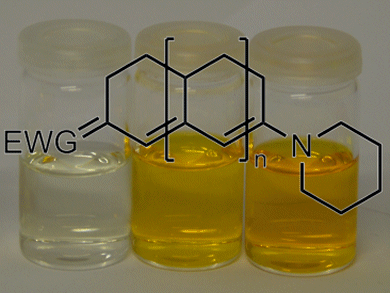Merocyanine compounds belong to the class of “push–pull” dyes and show multifunctional characteristics. Thus, their scope for application is ever increasing and they can be found in such widespread fields as data storage and UV-absorbing materials for food packaging. However, inherent limitations regarding long-term stability, efficiency, and processability require detailed studies on structure–property relationships.
An international collaboration involving the groups of Sabine Laschat, University of Stuttgart, Germany, and S. Holger Eichhorn, University of Windsor, Canada, experimentally and theoretically investigated a library of rigidified tri-, penta-, and heptamethine merocyanine dyes with increasing chromophore lengths and different acceptor units (pictured; EWG = electron-withdrawing group) like ketone, malononitrile and hexyl cyanoacetate. Within these results a promising ketone candidate with fluorescence quantum yields up to 95 % was found.
In addition, the team demonstrated that the popular assumption that solvent influence on the electronic spectra of merocyanines can be described solely based on the difference of the electronic energy of the ground and the excited state is misleading.
- Influence of Chromophore Length and Acceptor Groups on the Optical Properties of Rigidified Merocyanine Dyes,
Katharina Christina Kreß, Thomas Fischer, Joachim Stumpe, Wolfgang Frey, Melanie Raith, Omid Beiraghi, S. Holger Eichhorn, Stefan Tussetschläger, Sabine Laschat,
ChemPlusChem 2013.
DOI: 10.1002/cplu.201300308




